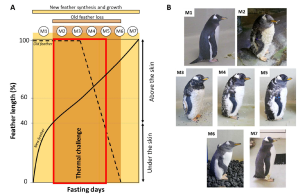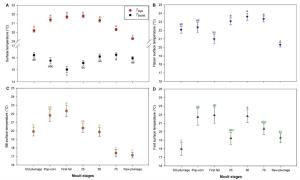Changes in surface temperatures reveal the thermal challenge associated with catastrophic moult in captive Gentoo penguins
Posted on: 5 March 2024 , updated on: 6 March 2024
Preprint posted on 17 January 2024
One too many layers? The thermal challenges associated with moulting in Gentoo penguins.
Selected by Jasmine TaleviCategories: physiology
Background
If you were to venture to Antarctica, odds are you would have many layers of clothing to keep you warm, but how many is too many? The Gentoo penguin experiences a similar challenge during a moult. Once a year, penguins go through a “catastrophic” moult where they replace their entire plumage of feathers by shedding the old feathers and growing new ones. At one point during this moult, the penguins will have two layers of feathers as the new ones begin to emerge while the old ones remain attached (Fig. 1). This double layer of feathers increases the thermal insulation for penguins. This is a challenge that may develop with rising air temperatures associated with global warming.
In addition to the potential heat stress caused by this double insulation of feathers, moulting is an energetically costly event for penguins. To support the synthesis of new feathers, the metabolic rate of penguin’s increases, consequently increasing heat production. Furthermore, penguins undergo this moulting event fasted, as foraging in cold water would lead to high conductive heat loss. In this preprint, Dr. Agnès Lewden and colleagues set out to investigate how the changes in body insulation and challenges of a moult could affect captive Gentoo penguins.

Fig. 1: Identification of the seven main moulting stages (stages M1 to M7) characterized during the Gentoo moult in captivity. The schematic representation of the penguin moult (A) shows the new feathers (straight-line) grow beneath the outer skin layer until 40% of their total length. Between 40 and 60% of new feather growth, penguins have a double feather layer, old (dashed line) and new. These two feather layers could lead to a thermal challenge for heat dissipation (red box). After 60% of new feather growth, the old feathers are starting to fall-off. Adapted from Groscolas and Cherel (1992). During moult, visual plumages changes can be noticed (B) and characterized into seven different stages: M1 = uniform old plumage, M2 = ‘pop-corn’ (superposition of old and new immature feathers), M3 = first fall of old plumage, M4 = 25% of old feathers fallen, M5 = 50% of old feathers fallen, M6 = 75% of old feathers fallen and M7 = uniform new plumage corresponding at the end of the monitoring.
Key Findings
Thermal imaging techniques were used to estimate the surface temperature of well-insulated body regions (old and new plumage: Ttrunk) and poorly insulated body regions of Gentoo penguins (thermal windows: bill, flipper, and foot). Additionally, thermal imaging around the eye (periorbital region: Teye) was used as a proxy for core temperature. The captive conditions allowed for the measurement of individuals throughout the entire moult under uniform air temperature, avoiding the confounding effects that wind, precipitation, and solar radiation may pose. The authors’ findings suggest:
1) Double feather layer increases insulation.
During early moulting stages when penguins had two feather layers, core temperature (Teye) was elevated (Fig. 2). Additionally, insulated body regions (Ttrunk) showed the lowest surface temperature and the thermal windows (bill, flipper, and foot) generally showed elevated surface temperatures, suggesting greater insulation of the trunk region and more heat dissipation through the thermal windows during this moult stage. This pattern was observed until approximately halfway through the moult, at which point feather loss began to increase. With increased feather loss, core temperature (Teye) decreased, the surface temperature of insulated body regions increased (Ttrunk), and the surface temperature of the thermal windows (bill, flipper, and foot) decreased (Fig. 2).
2) Thermal windows may be important for heat dissipation.
A high surface temperature of the thermal windows was observed during the double feather moult period, which is likely a mechanism that helps to dissipate excess heat. Additionally, the reduction of thermal window surface temperatures after old feather loss could be associated with vasoconstriction, a mechanism that reduces heat loss when plumage insulation is lower. Since this study was conducted in the thermal neutral zone of Gentoo penguins, theoretically any changes in metabolic rate and heat production would be a result of the moult and not associated with thermoregulation.

Fig. 2: Least-squared mean surface temperatures during the seven moulting stages. Values for the periorbital region (red) and the trunk (black) (A), the flipper (B), the bill (C), and the foot (D) are shown. Values that do not share the same letter are significantly different from each other (post-hoc Tukey’s HSD test; P<0.05).
Why I Chose This Preprint
As a scientist who also studies the implications of thermal stress and metabolic rate (in my case, in marine bivalves), it is interesting to compare the different physiological mechanisms and adaptive behaviours that other species implement to combat thermal challenges. This preprint also highlights how animals living in some of the coldest regions on earth, during a thermally vulnerable period, are potentially still impacted by thermal stress. I found this surprising, and as mentioned by the researchers, many other Antarctic animals show evidence of heat loss during a moulting period. Information like this can help us understand which species may be more vulnerable to climate change to predict the impacts of possible future ecological challenges.
Questions for Author
- Is there some proteomic or transcriptomic response that could be measured during the double insulation moult stage to investigate if the penguins are under thermal stress?
- Do you think the habitat range of Gentoo penguins will shift northward if temperatures in their current regions become too warm?
- If this study were to be replicated in the wild, do you predict that the thermal stress of having two layers of feathers would be mitigated or amplified by the wind, solar radiation, and precipitation that are typically experienced during the moulting season of Gentoo penguins?
Future Directions
I think coupling the thermal imaging techniques used in this paper with proteomic level responses (ex. heat shock proteins, reactive oxygen species) could provide a deeper understanding of the thermal challenge Gentoo penguins face with two layers of feathers during a moult. Additionally, it would be interesting to replicate this study in the wild to understand how the combination of wind, solar radiation, and precipitation would impact thermal stress during the double insulation moult period.
doi: https://doi.org/10.1242/prelights.36544
Read preprintSign up to customise the site to your preferences and to receive alerts
Register hereAlso in the physiology category:
Imaging cellular activity simultaneously across all organs of a vertebrate reveals body-wide circuits
Muhammed Sinan Malik
Wide-ranging behavioral dysfunction in two mouse models of pathological human variants in the GRIK2 kainate receptor gene
Pushpinder Singh
Fibroblast growth factor 21 regulates neuromuscular junction innervation through HDAC4 in denervation-induced skeletal muscle atrophy
Jórdan Sampar
preLists in the physiology category:
October in preprints – DevBio & Stem cell biology
Each month, preLighters with expertise across developmental and stem cell biology nominate a few recent developmental and stem cell biology (and related) preprints they’re excited about and explain in a single paragraph why. Short, snappy picks from working scientists — a quick way to spot fresh ideas, bold methods and papers worth reading in full. These preprints can all be found in the October preprint list published on the Node.
| List by | Deevitha Balasubramanian et al. |
Biologists @ 100 conference preList
This preList aims to capture all preprints being discussed at the Biologists @100 conference in Liverpool, UK, either as part of the poster sessions or the (flash/short/full-length) talks.
| List by | Reinier Prosee, Jonathan Townson |
Fibroblasts
The advances in fibroblast biology preList explores the recent discoveries and preprints of the fibroblast world. Get ready to immerse yourself with this list created for fibroblasts aficionados and lovers, and beyond. Here, my goal is to include preprints of fibroblast biology, heterogeneity, fate, extracellular matrix, behavior, topography, single-cell atlases, spatial transcriptomics, and their matrix!
| List by | Osvaldo Contreras |
FENS 2020
A collection of preprints presented during the virtual meeting of the Federation of European Neuroscience Societies (FENS) in 2020
| List by | Ana Dorrego-Rivas |
TAGC 2020
Preprints recently presented at the virtual Allied Genetics Conference, April 22-26, 2020. #TAGC20
| List by | Maiko Kitaoka et al. |
Autophagy
Preprints on autophagy and lysosomal degradation and its role in neurodegeneration and disease. Includes molecular mechanisms, upstream signalling and regulation as well as studies on pharmaceutical interventions to upregulate the process.
| List by | Sandra Malmgren Hill |
Cellular metabolism
A curated list of preprints related to cellular metabolism at Biorxiv by Pablo Ranea Robles from the Prelights community. Special interest on lipid metabolism, peroxisomes and mitochondria.
| List by | Pablo Ranea Robles |











 (No Ratings Yet)
(No Ratings Yet)